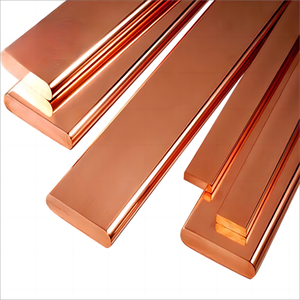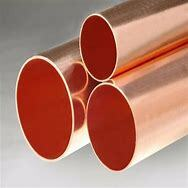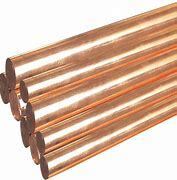1. Introduction
When you hear ‘copper rod,’ you might picture a simple metal bar—but in reality, this term encompasses a surprisingly diverse range of products with specialized uses across industries. From earthing systems that protect buildings from lightning strikes to precision welding rods and conductive strips in electrical panels, copper rods and their flat counterparts—copper strips—play vital roles in modern infrastructure. Understanding the differences between solid copper rod, copper bonded earthing rod, copper clad steel ground rod, and even copper brazing rod can save time, money, and ensure safety. In this guide, we’ll break down these variations, compare performance, and clarify where each type shines.

2. Types of Copper Rods and Their Applications
2.1 Solid Copper Rod vs. Copper Bonded and Clad Variants
A true copper rod—often called rod copper or copper round bar—is made entirely of high-conductivity electrolytic copper. These are used in electrical busbars, motor windings, and high-end welding applications. However, due to copper’s cost, alternatives like copper bonded steel and copper clad steel earth rod have gained popularity, especially in grounding systems. Copper bonded earthing rods feature a steel core with a thick electroplated copper layer (typically 0.25mm or more), offering tensile strength from steel and corrosion resistance from copper. Copper clad ground rods use a metallurgical bond to fuse a copper sheath over steel, providing similar benefits but with slightly different manufacturing processes. Both are cheaper than solid copper yet still meet most earthing standards.
2.2 Earthing Rods: Choosing the Right Ground Rod Copper
For electrical safety, the earthing rod copper must conduct fault currents reliably and resist soil corrosion. Solid copper earth rods are ideal for highly corrosive soils but come at a premium. Copper bonded ground rods offer a cost-effective middle ground—strong enough for rocky terrain and corrosion-resistant enough for most environments. When comparing earthing rod price, solid copper can cost 3–5 times more than copper bonded options. The copper earth strip 25x3mm price also varies based on purity and supplier, but it’s often used alongside rods in grounding grids. Always verify local electrical codes: some regions require minimum copper thickness for bonded rods.
3. Copper Rods in Joining and Fabrication

3.1 Copper Brazing and Welding Rods
Not all copper rods are for conduction—some are for joining. Copper brazing rod and copper to copper brazing rods are used in HVAC, plumbing, and refrigeration to fuse copper components without melting the base metal. These often contain phosphorus (as in CuP alloys) to act as a fluxing agent. For welding, copper welding rod or copper to copper welding rod is selected based on the alloy being joined. Pure copper rods can be tricky to weld due to high thermal conductivity, so specialized techniques or preheating are often needed. Copper rod for welding is rarely pure copper; it’s usually an alloy like ERCu or ERCuSi-A for better fluidity and strength.
3.2 Practical Considerations in Copper Rod Welding
Copper rod welding demands clean surfaces and proper heat control. Unlike steel, copper dissipates heat rapidly, requiring higher amperage or preheating. Using a welding rod copper designed for the specific base metal is crucial—mismatched rods can lead to weak joints or porosity. For DIYers or small shops, brazing with copper to copper brazing rods is often easier and more forgiving than true fusion welding.
4. Copper Strips: From Earthing to Scrap Recycling
4.1 Electrical and Structural Uses of Copper Strip

While rods are round, copper strip (also called flat copper strip, copper metal strips, or copperstrip) serves different functions. Copper strip for earthing is common in substation grounding mats. Thin copper strips like 1mm copper strip or beryllium copper strip are used in springs, connectors, and EMI shielding. Nickel plated copper strip enhances solderability and corrosion resistance in electronics. Copper roof strip and copper edging strip protect building edges from weathering while adding aesthetic value.
4.2 Stripping and Recycling Copper Wire
Many search for the best way to strip copper wire because clean, bare copper fetches higher scrap prices. Burning copper wire for scrap is dangerous and illegal in many areas—it releases toxic fumes and degrades copper quality. Instead, mechanical strippers or automated machines offer a fast way to strip copper wire. For thick cables, industrial strippers work best; for household wire, manual tools suffice. Stripping copper wire for scrap is worth it if you have volume—clean #1 copper can sell for significantly more than insulated wire. Always avoid ‘stripping cable for copper’ with open flames; it’s neither safe nor profitable in the long run.
5. Pricing and Sourcing Insights
Copper rod price fluctuates with the LME (London Metal Exchange) rates. As of recent markets, solid copper round bar costs more than copper bars for sale made from recycled content. Similarly, copper strip price depends on thickness, alloy, and form—roll of copper strip is cheaper per meter than cut lengths. For those searching ‘copper strip near me,’ local metal suppliers or electrical wholesalers often stock standard sizes like copper earth strip 25x3mm. Flexible copper bus bar and copper flat bar are pricier due to specialized manufacturing but essential in high-vibration environments.
6. Conclusion
Whether you’re installing a grounding system, repairing an air conditioner with 15mm copper pipe, or recycling old wiring, understanding the nuances between copper rod types and copper strip variants is essential. Solid copper offers unmatched conductivity but at a cost; copper bonded and copper clad alternatives provide smart compromises for earthing. Meanwhile, proper wire stripping—not burning—is the best way to maximize scrap value. With the right knowledge, you can choose the optimal copper product for performance, safety, and budget.
Our Website founded on October 17, 2012, is a high-tech enterprise committed to the research and development, production, processing, sales and technical services of ceramic relative materials such as Copper. Our products includes but not limited to Boron Carbide Ceramic Products, Boron Nitride Ceramic Products, Silicon Carbide Ceramic Products, Silicon Nitride Ceramic Products, Zirconium Dioxide Ceramic Products, etc. If you are interested, please feel free to contact us.

